Potential contributions to Beijing’s water supply from reuse of storm- and greywater
Liu Li Marina Bergen Jensen Meng Qingyi
(1Department of Geosciences and Natural Resource Management, University of Copenhagen, Frederiksberg 1958, Denmark)(2Sino-Danish Center for Education & Research, Beijing 100191, China)(3Beijing Water Science and Technology Institute, Beijing 100048, China)
Potential contributions to Beijing’s water supply from reuse of storm- and greywater
Liu Li1,2Marina Bergen Jensen1Meng Qingyi3
(1Department of Geosciences and Natural Resource Management, University of Copenhagen, Frederiksberg 1958, Denmark)(2Sino-Danish Center for Education & Research, Beijing 100191, China)(3Beijing Water Science and Technology Institute, Beijing 100048, China)
In order to find new approaches to alleviating the water crisis in Beijing, which is caused by, among others, dwindling precipitation and rapid growth of population, and manifests in a rapidly declining groundwater table, this study explores decentralized stormwater harvesting and greywater reuse at household level as a means to reduce groundwater abstraction and water transfer from other regions. Based on a desktop case study, two concepts for combined harvesting and reusing of storm- and greywater are presented. With rough pre-assumptions, calculations show that a saving of 67.8% of tap water consumption can be achieved with the upgrading concept, compared with 5.9% with the simple downgrading concept. The saving with the upgrading concept equals 0.545×109m3annual water volume, if 20 million Beijing people apply this approach. Despite numerous prerequisites, such as water treatment technology, space demand, energy and cost, and public acceptance, this paper advocates combining stormwater harvesting and greywater reuse in households with other measures for Beijing’s sustainable water management.
urban water cycle; water supply; water reuse
In per capita terms, China’s water resources are not rich, accounting for about 75% of the average of Asia and 35% of the average of the world[1]. The water resources are unevenly distributed geographically and seasonally. 80.4% of China’s precipitation falls in the area south of the Yangtze River, but it is available for only 53% of China’s population, 35.2% of the arable land and 55.5% of GDP. Water availability per capita in south of the Yangtze is almost four times that of the north regions, and per hectare of arable land about eight times greater[1].
China’s economic development is mainly associated with urban areas, but the distribution of the Chinese cities is uncoordinated with water resources. Because of this, cities face great water challenges. This is especially the case for China’s capital city, Beijing. It has developed into the country’s political, cultural and economic center, while at the same time facing severe environmental and resource challenges, among which is the lack of freshwater resources.
Beijing is located in a dry climate with limited freshwater resources. Rapid growth in both population and the economy in the recent two decades has deteriorated the situation. Currently, Beijing’s water resource per capita is less than 300 m3, about 1/8 of the country average and 1/30 of the world average[2]. While the annual precipitation is decreasing, the city’s water consumption keeps growing. Based on data from 2009, to meet the annual demand of 3.55×109m3, Beijing’s natural groundwater resources are grossly overexploited[3].
To provide more water, the city takes two major strategies: reclaiming water from wastewater treatment plants, and diversion of water from the Yangtze River in the south, 1267 km away and 119 m lift up through the South-North Water Transfer Project (SNWT). Today, approximately 68% of all treated wastewater from urban water treatment plants is reclaimed, providing approximately 1/5 of the total demand. When the SNWT project is completed in 2014, it is expected to relieve the pressure of demand on groundwater. It is, however, insufficient for reestablishing the groundwater table. Water saving, pricing systems and some stormwater harvesting actions are applied in Beijing, but these count less compared with the two major strategies. New concepts are needed to save and use available water resources more efficiently.
Fig.1 shows Beijing’s water supply, discharge, and consumption in 2009. Precipitation is based on the average annual precipitation of 457mm between 1999 and 2009. Of the annual precipitation of 7.45×109m3in Beijing City (16410 km2) only 2.03×109m3is available for the city as a water resource. Most of the precipitation (5.42×109m3) goes directly back to the natural water cycle by evaporation, canopy interception, infiltration, etc. The city has to depend on groundwater and imported water from other regions for water supply. Groundwater abstraction (2.17×109m3) compared with groundwater replenishment (1.36×109m3) reveals 160% overexploitation of groundwater in the year 2009. Overexploitation has resulted in a drop in groundwater level from approximately 3 m below the surface in the 1960s to 24 m below the surface in 2009, leaving only 11 m before the dry bedrock is reached. The drop rate has gradually increased and reached 1.2 m on average in the 2000—2009 period. A positive aspect is that a substantial amount of wastewater is reclaimed and reused for the city’s water supply. When the SNWT project is in function in 2014, the amount of imported water in the left of the figure will be much bigger, and groundwater abstraction is expected to decline.
Having set the scene with this overview of the critical situation of Beijing’s water resources, the aim of this paper is to discuss options for closing the urban water cycle by means of decentralized stormwater harvesting and greywater reuse. We assess two concepts for combined harvesting and reuse of storm- and greywater in urban households, followed by a discussion of advantages and drawbacks of these concepts.
1 Background of Concepts
1.1 Impact of urbanization on urban water cycle
Urbanization has a significant impact on the local natural water cycle. When a natural or rural setting is urbanized, the most visible consequence is the increase of ground imperviousness that limits stormwater infiltration and thus reduces the recharge of groundwater aquifers. On the water supply aspect, the increase in urban population and improved sanitation result in increased water consumption. For economic reasons, the supply water is typically withdrawn from the closest source like rivers or local aquifers. This often results in lowering surface water flows and the groundwater table, which may bring further problems such as drying out of rivers and land subsidence[4]. As one of the urbanization practices, construction of networks for runoff conveyance and discharge increases the catchment runoff volumes and shortens the response time. Canalization of urban streams and rivers further breaks down the natural water networks’ self-adjustment mechanism and increases the risk for flooding, when the flow exceeds the defined capacity.
Water enters urban areas as relatively clean groundwater, rainwater and surface water. Water leaves urban areas mainly in the form of urban wastewater effluents (UWWE), including stormwater runoff, municipal wastewaters, and combined sewer overflows (CSO). UWWE is discharged into receiving surface waters ranging from streams, rivers, lakes, reservoirs to estuaries and oceans. Although UWWE is often treated before discharge, untreated wastewater and left-over pollutants result in an increase of pollutants concentration in receiving waters. Pollutants also get into groundwater aquifers through natural leaching or intentional infiltration of stormwater runoff. When the pollutants in the receiving surface water bodies and groundwater aquifers exceed certain levels, this will cause the loss of beneficial water uses, for example, drinking water safety, ecological functions, and urban water for recreation and amenity[4].
A common approach to urban water management is the fragmentation of the urban water cycle into sectors, where water supply, stormwater and wastewater are managed in separate and non-circular systems without taking advantage of the numerous links between them. For example, lack of integration leads to missing the opportunity of using rainwater and recycled wastewater as a water source for non-potable uses. In other cases, over-abstraction of river water without thinking of the reduced ability to support downstream regions may bring unexpected impacts[5]. Thus urbanization and conventional approaches to urban water management result in an unbalanced urban water cycle from both quantity and quality points of view. In order to close the urban water cycle and regain the balance, an integrated urban water management approach is needed at the strategy and planning levels as well as on technical levels, allowing for water supply systems to be linked to systems for storm- and wastewater discharge systems.
1.2 Aspects on urban water reuse—stormwater and greywater
Reuse of water for urban water supply is a key issue for achieving a closed water cycle, especially in resource poor cities. Water for reuse in urban areas can be sourced from stormwater, greywater, industrial wastewater and effluent from municipal wastewater treatment plants. Water reuse can reduce both demands for fresh water resources and pollution loads to surface water.
1.2.1 Stormwater
Stormwater is defined as the runoff from pervious and impervious surfaces in predominantly urban environments. Impervious surfaces include roofs, drive ways, pavement, footpaths, and roads[6]. It flows directly into surface waterways or is channeled into sewers, which eventually discharge to surface waters. Urban stormwater includes pollutants, such as sediments, nutrients, organic macro-pollutants like plant debris, heavy metals, oil and grease, hydrocarbons, organic micro-pollutants like pesticides and PAH’s, road deicing agents like NaCl, and pathogens[7]. The stormwater harvesting system depends on the rainfall characteristics, area of runoff catchment, water demand for specified usage(s), water quality and storage area required due to seasonal variation[6]. Examples of significant stormwater harvesting do exist, for instance in Sharland Oasis, Australia, where 40% of the total water supply is based on rain water[8].
1.2.2 Greywater
Greywater is all wastewater except for blackwater (toilet water) produced in households. It includes water from showers, bathtubs, sinks, dishwashers, washing machines and water used for cleaning. The fraction of greywater in household wastewater is up to 75%[9]. Sometimes, wastewater from the kitchen is also excluded as greywater for reuse, because it is more heavily contaminated than greywater from other sources[10]. According to Australian experience, reuse of greywater for toilet flushing and lawn gardening could achieve water savings from 30% to 50% of total household water usage[8]. Greywater is of lower quality than harvested stormwater, as it contains dissolved contaminants from detergent or soap products, household chemicals, nutrients, pathogens, etc. However, greywater is produced more regularly, allowing for a smaller storage volume compared with stormwater[11]. Examples of greywater treatment technologies include constructed wetlands, rotating biological contactors (RBC), sequencing batch reactors (SBR), and membrane bioreactors (MBR)[12]. Greywater systems have disadvantages compared with stormwater harvesting from roof tops because of the greater technical challenges for treatment[6].
1.2.3 Reuse of storm-and greywater
During the past decade, reuse of water in cities has been intensively investigated especially in Australia, the European Union, Israel, Japan, Jordan and the USA[13]. For some countries like Germany, experience of reuse of stormwater and greywater has been collected over two decades. Treatment concept for greywater reuse, following a process of sedimentation, biological treatment, a clearing stage and eventually UV disinfection, has proved to be effective and suitable for household toilet flushing[10]. In Australia, the quality of treated stormwater from the existing practices is proved within the limits prescribed by the Australian Drinking Water Guidelines. The greywater treatment system, if following EPA Victoria Accreditation, can achieve a water quality suitable for garden watering, toilet flushing and use in washing machines[8].
Among many others, stormwater and greywater reuse demonstration cases can be found in Nordhavnsgaarden, at Østerbro, in Copenhagen, Block 6 in Berlin and two residential buildings of Beijing Water Infrastructure Corps. In Nordhavnsgaarden, greywater is collected from the showers of 130 apartments, treated in the basement by means of RBC and redistributed to 85 apartments for toilet flushing[14]. Block 6, Berlin uses a storm- and greywater recycling system. The high load greywater from kitchens and washing machines, in addition to greywater from bathtubs and showers from 71 dwelling units (250 persons), are collected and treated in SBR to produce water for toilet flushing and garden irrigation[15]. In the case of Beijing roof runoff from the two buildings is treated in an IRM High-Flow Inline filter and greywater from bathtubs and showers from one of the buildings is treated in RBC. The treated storm- and greywater are reused for toilet flushing respectively in each of the two buildings with 60 apartments each (120 persons)[16].
1.3 Objective
The objective of this study is to assess the water saving potential in households in Beijing upon stormwater harvesting and greywater reuse, following either a simple downgrading concept, or a multiple reuse upgrading concept. Furthermore, the major challenges of citywide greywater implementation are discussed.
2 Methods and Materials
The results presented reflect education-based research within the Sino-Danish Water and Environment Master Program (www.sdc.dk).
2.1 Two concepts for stormwater harvesting and greywater reuse
The down- and upgrading concepts are presented in Fig.2 and Fig.3, respectively.
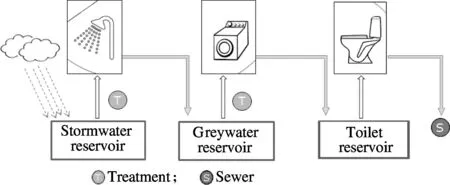
Fig.2 Concept 1: downgrading

Fig.3 Concept 2: upgrading
Concept 1(downgrading) The harvested stormwater is treated and used for the most sensitive purpose (personal hygiene, dish washing). The resulting greywater is treated and used for less sensitive purposes (laundry, cleaning), and then for the least sensitive purpose(toilet flushing), in a cascading manner, where the quality requirements become less in each step. The harvested stormwater is reused three times. Three separate tanks, at least two treatment technologies, and the conventional tap water backup system are required.
Concept 2(upgrading) Storm- and greywater are mixed in the same tank. Treatment ensures adequate water quality for personal hygiene, dish washing and thus all inferior uses. In dry periods, the tank is replenished with tap or reclaimed water to the minimum level. The harvested stormwater is used multiple times, and water is only leaving the storage tank through the toilet. A single treatment technology for stormwater and greywater treatment to top quality is needed. The conventional in-house tap water system is needed for kitchen uses only.
2.2 Case description and data input
The concepts are applied to a nine-story block buildingserving as a student dormitory at Chinese Academy of Science in Beijing, located on No.3, Datun Road, Chaoyang District, Beijing. The neighboring stormwater catchment area is approximately 4800 m2, including the roof area and the surrounding pavements. The annual precipitation of Beijing is 457 mm (see Fig.1). It is assumed that 80% of the annual precipitation can be harvested and stored.
The dormitory contains 432 three-person-shared rooms, corresponding to approximately 1300 residents in total (see Fig.4).
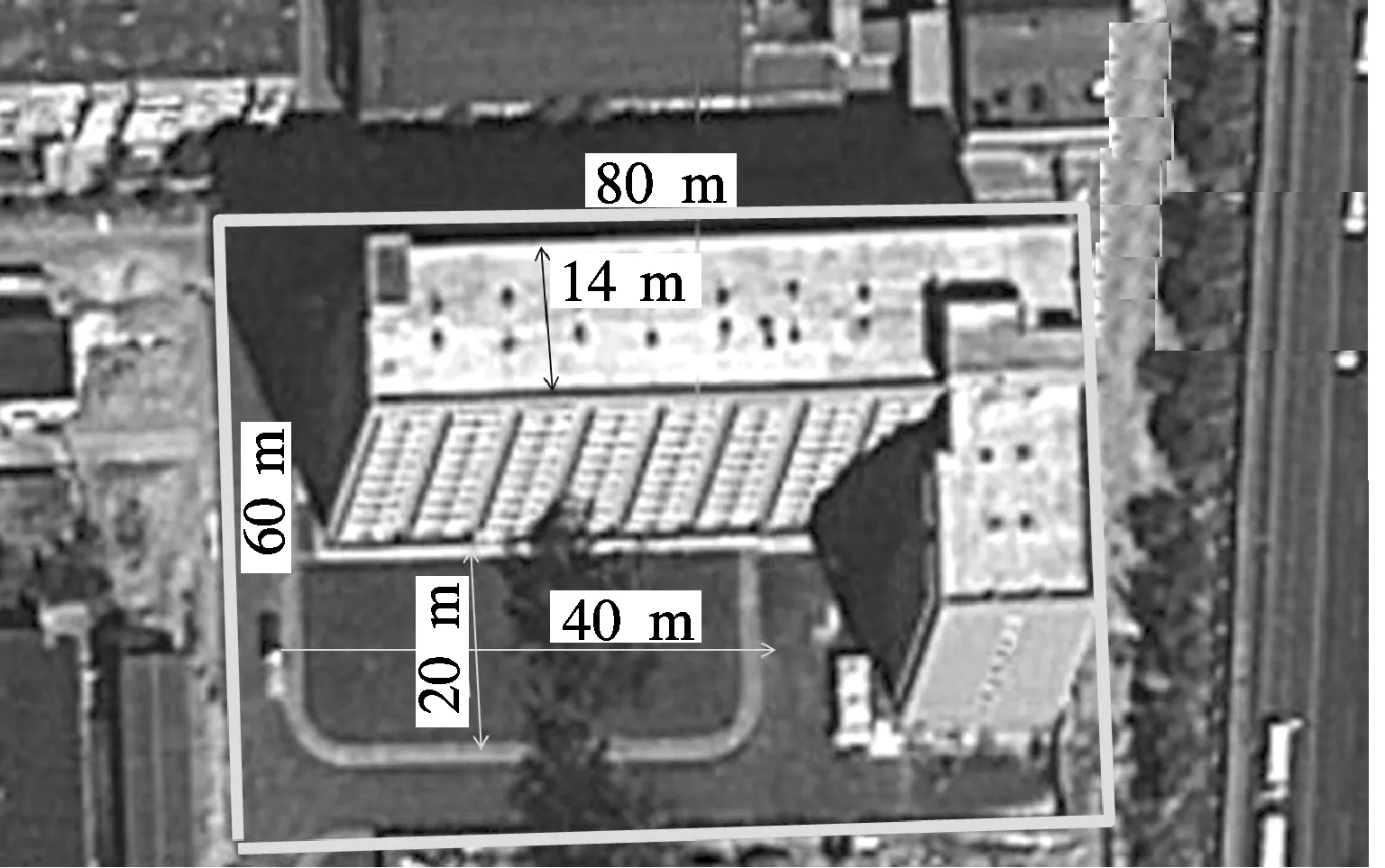
Fig.4 The block building site (based on Google earth, 2013)
Household water consumption is estimated to 200 L/(person·d) based on Beijing Water Resource Bulletin 2009[3,17]. Water use distribution in households (see Fig.5) is based on data from Denmark[18], as data for Beijing are not available.
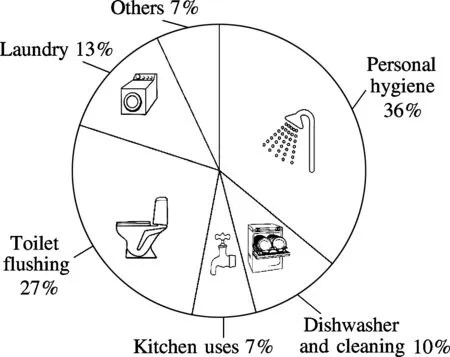
Fig.5 Water distribution in households[18] (DANVA)
For both concepts it is assumed that storm- and greywater can be treated to a quality allowing for replacement of all tapwater except water for kitchen uses. It is further assumed that no water is lost during water use activities.
3 Results
3.1 Water saving potential
With a runoff coefficient of 0.8 and an annual precipitation of 457 mm the stormwater harvesting potential from the 4800 m2dormitory catchment area amounts to
Stormwater harvest=
0.8×4800m2×0.457m3/m2=1755m3
With a 200 L/(person·d) water consumption by the 1300 residents, the total annual water demand amounts toUsing the ratios for water distribution in Danish households (see Fig.5), the total water demand in the dormitory distributes as shown in Tab.1, which also categorizes the water demand after quality requirements and category after use.
Total water demand=0.2m3/(person·d)×
365 d/a×1300 persons=94900m3
Tab.1 Annual water demand in dormitory with 200 L/(person·d) for different uses, corresponding water quality requirement and category after use
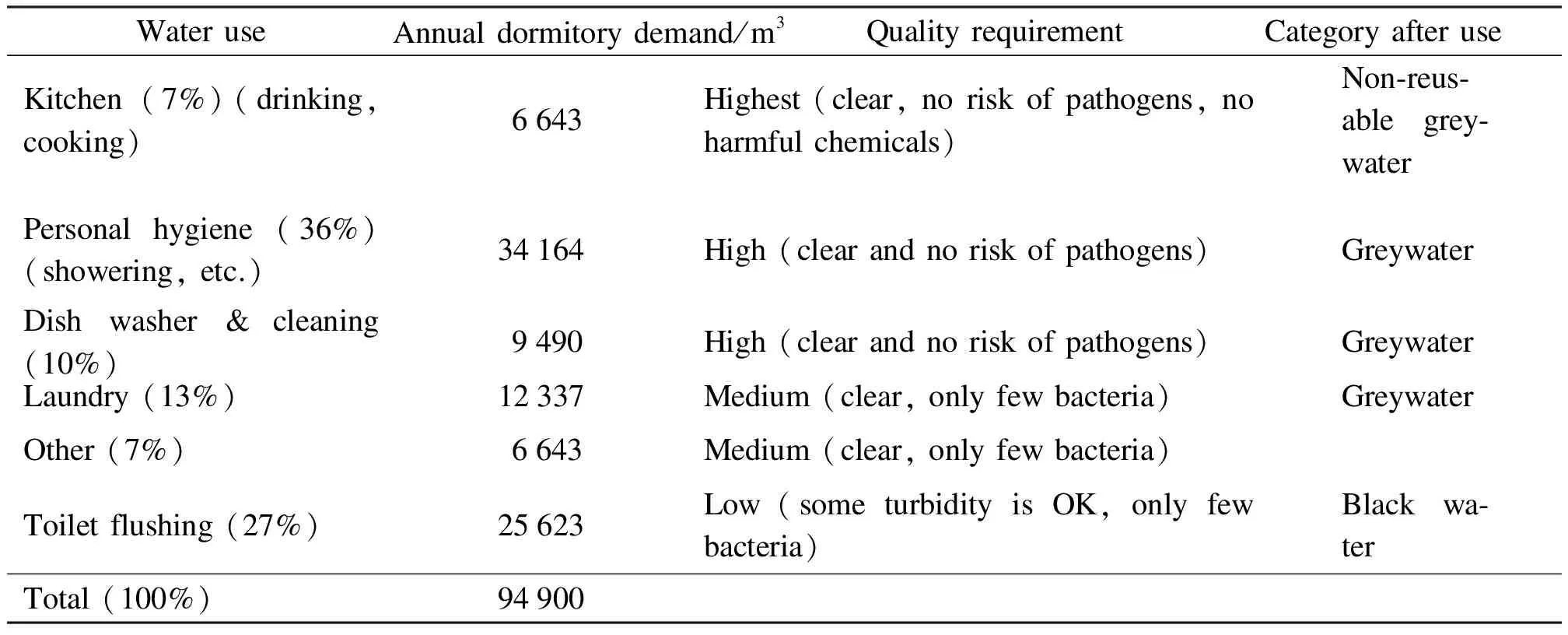
WateruseAnnualdormitorydemand/m3QualityrequirementCategoryafteruseKitchen(7%)(drinking,cooking)6643Highest(clear,noriskofpathogens,noharmfulchemicals)Non⁃reus⁃ablegrey⁃waterPersonalhygiene(36%)(showering,etc.)34164High(clearandnoriskofpathogens)GreywaterDishwasher&cleaning(10%)9490High(clearandnoriskofpathogens)GreywaterLaundry(13%)12337Medium(clear,onlyfewbacteria)GreywaterOther(7%)6643Medium(clear,onlyfewbacteria)Toiletflushing(27%)25623Low(someturbidityisOK,onlyfewbacteria)Blackwa⁃terTotal(100%)94900
The water saving potential in the downgrading concept is estimated by multiplying the stormwater storage with a factor of 3 as the stormwater is reused three times before discharged to the sewer. The amount of tap water needed in this concept amounts to
Downgrading tapwater demand=total water
demand-three times reuse of stormwater=
94900 m3-3×1755 m3=89275 m3
The downgrading concept results in water saving of
Water saving downgrading=

In the upgrading concept the water level in the storage tank drops only when toilets are being flushed. All other uses of water in the tank will not result in a reduction in volume as the water is returned to the tank after use. Thus the volume in the tank can be used for all other purposes multiple times, before the water is flushed through the toilets to the sewer. In this way the demand for tap water equals the kitchen and toilet flushing demand, subtracted the harvested stormwater:
Upgrading tapwater demand=kitchen water+
toilet flushing water-harvested stormwater=
6643 m3+25623 m3-1755 m3=30511 m3
The upgrading concept results in water saving of
Water saving upgrading=

3.2 Comparison of the two concepts
Tab.2 compares the two concepts for combined harvesting and reuse of storm- and greywater in urban households as introduced above.
Tab.2 Comparison of the two concepts for stormwater harvesting and greywater reuse in households
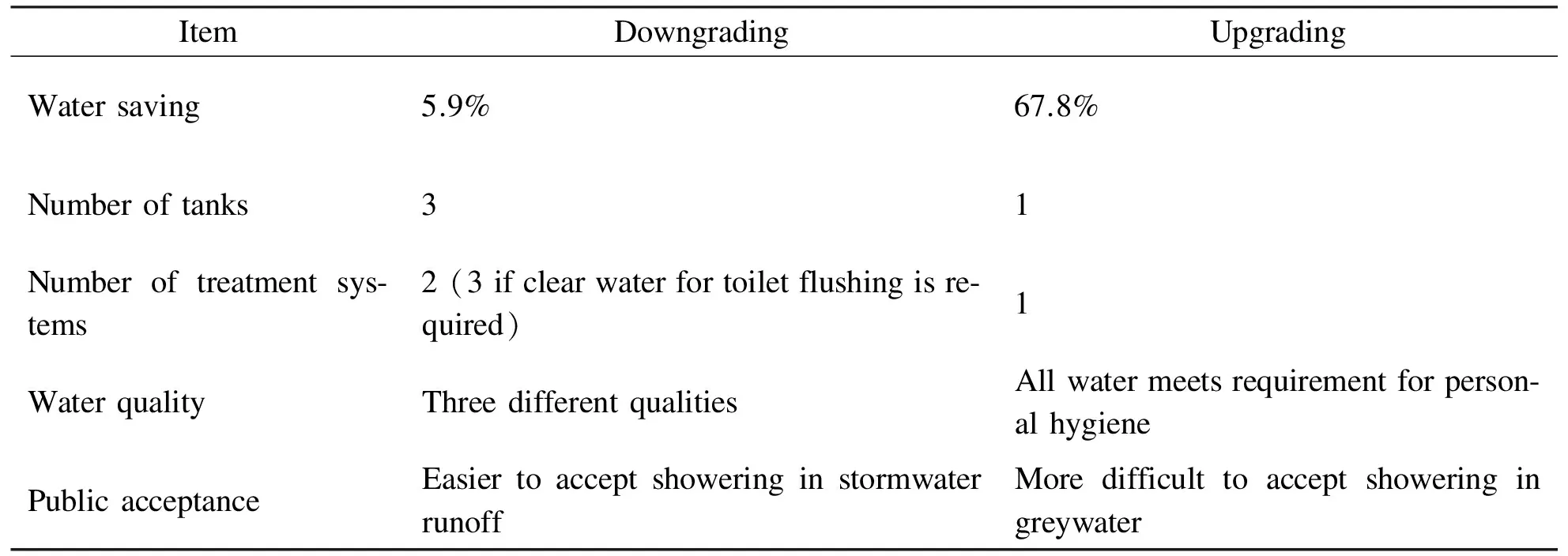
ItemDowngradingUpgradingWatersaving5.9%67.8%Numberoftanks31Numberoftreatmentsys⁃tems2(3ifclearwaterfortoiletflushingisre⁃quired)1WaterqualityThreedifferentqualitiesAllwatermeetsrequirementforperson⁃alhygienePublicacceptanceEasiertoacceptshoweringinstormwaterrunoffMoredifficulttoacceptshoweringingreywater
3.3 Upscaling to Beijing city
If 20 million Beijing people cut their daily use of tapwater by harvesting stormwater and reusing greywater as in concept 2 (67.8% reduction) it will correspond to an annual water volume of
Upscaled saving=2×107persons×0.2 m3/
(person·d)×365 d×67.8%=0.99×109m3
4 Discussion
The annual water saving, if the upgrading concept is applied citywide, of almost 1×109m3represents a signi-ficant fraction compared with the annual water supply of 3.55×109m3(see Fig.1). The number is so high that it is likely to overrule the many rough and to some extent unrealistic assumptions, for instance the neglect of evaporation loss, this estimate is based on.
A study in Ireland estimates that optimized integration of the storm- and greywater reuse system will save 94% of public water supply in Ireland[11], also based on stormwater harvesting and greywater reuse but in two separate systems. This high value reflects a significant stormwater contribution. But for cities with poor rainfall like Beijing the stormwater resource will be minor and reuse systems will have to rely more on multiple greywater recycling, as suggested in the upgrading concept (see Fig.3). No documentation is found for applications like concept 2. However, initiatives by the authors in cooperation with local public baths have been started in Copenhagen to test the upgrading concept.
Worldwide, most common practices for storm- and greywater reuse provide water for toilet flushing, irrigation, car washing and similar low-quality water uses. In Germany there are standards for greywater reuse for toilet flushing, but not for other purposes[10]. With advanced and thus more costly treatment processes greywater can be reused for laundry and personal hygiene[11].
According to Nolde[10]water from recycling systems should fulfill four criteria: hygienic safety, technical and economic feasibility, aesthetics and environmental tole-rance. Water recycling for households is still a new approach in Beijing. The two proposed concepts for household water reuse can be considered long-term scenarios based on theoretical potentials rather than well-proved models that are ready for application. Various challenges can be expected, considering current socio-cultural and technical realities in Beijing.
4.1 Challenges on space, energy and cost
The uneven seasonal distribution of precipitation in Beijing with almost all rain in only three months requires large storage capacity, which may be in conflict with the limited space in urban Beijing. Innovative ways to provide space for local water storages would be to construct buildings with space in the basement, on the top floor, or at the façades.
Solutions for saving the freshwater resource should not be at the expense of higher greenhouse gas emissions. A German study shows that in large multistage Rotating Biological Contactor (RBC) greywater systems, the energy demand for greywater treatment, UV disinfection and treated water distribution is less than 1.5 kW·h/m3[10]. Likewise, storm- and greywater reuse systems should not cause chemical contamination and should use no or less chemicals compared to conventional waterworks.
In a study of economic feasibility of on-site greywater reuse in multi-storey buildings, assuming only the individual consumers pay for the system, it is estimated that the RBC-based system needs less than 0.5% investment costs for buildings of more than 20 flats, while MVR-based systems need 1.7% of flat price for the same building size. If implemented at city scale the added benefits of reduced overall water consumption and reduced sewage flows increase the cost-effectiveness of on-site storm- and greywater reuse systems[19].
4.2 Challenges on public acceptance: water quality, health issue and psychological acceptance
It was more than a decade ago that a strategy of storm- and greywater reuse for toilet flushing was introduced and the first generation of demonstration projects was established in Beijing. However, the plan of spreading this strategy was put aside after a few years. The main reason was the fear of health risk, especially after the outbreak of severe acute respiratory syndromes (SARS) during 2002 to 2003. For the implementation of the two concepts mentioned here, more challenges for public acceptance are expected, since more personal hygiene issues are involved when storm- and greywater are used for shower-ing, dishwashing and laundry.
A study in Australia shows that public acceptance to greywater reuse was high for uses such as toilet flushing and watering gardens. Willingness decreased when it came to body contact with greywater[8]. Earlier studies in European cities point to health risk, costs, operation regime and environmental awareness as factors of importance to public acceptance of storm- and greywater reuse[20]. According to Nolde[10]common chemicals from bath (including occasional medicinal baths) and house cleaning, and even pathogens from faeces and other sources expose no health risk, if greywater systems are properly functioning with efficient carrier materials for biofilm fixation and UV disinfection.It should be noted that lack of negative examples may be due to the fact that high level human contact with recycled water is not a common practice[20].
To reach a higher satisfaction level for the recycling system, both technological improvements and better communication with the stakeholders, especially the users, are important. German experiences recommend that every greywater system be tested once before operation, under several different contamination conditions, and the recycled water pipe system being in special color (purple is used in Australia) to avoid cross connections with the drinking water network[10]. Users need to be motivated and effectively involved in the process. Since the user’s behavior influences the composition of greywater and therefore the complexity of the treatment procedure, greywater reuse programs need to be combined with public education for proper household water use behaviors. Public education on environmental awareness and the awareness of water challenges in Beijing may motivate a large amount of citizens and greatly improve the public acceptance to recycled storm- and greywater for household uses, where toilet flushing may be a good starting point.
4.3 Prospect of storm- and greywater reuse in Beijing
As seen from Fig.1 Beijing’s water demands and resources are extremely unbalanced. The local water resources can by no means support the population and functions of the city. Beijing as a capital city and political, economic and cultural center for China may not be adequately located, or it has simply grown oversized. The water issue is closely linked with urban development as a whole, because most economic activities in a city are dependent on a reliable supply of water and a healthy living environment[5]. To this point, an optimum city planning may have an influence on releasing urban water stress by, for example, relocating some urban functions to other regions.
While Beijing’s action of using reclaimed water from wastewater plants is encouraging and inspiring for other cities, we keep a skeptical view to the SNWT project. It is likely based on enormous energy costs and engineering expenses, as well as environmental and social problems in the water source regions. We believe that much can be done to optimize the usage of local water resources, both in terms of water saving programs, and by promoting water reuse technologies, as the upgrading concept suggested here.
5 Conclusion
A review of Beijing’s water balance shows that groundwater is overexploited to meet the demands of the densely populated city. Drawbacks of the present water supply approach can be seen by the serious decline of the groundwater table and the tremendous water footprint of the city on regions far away. Beijing’s water stress represents a common urban challenge—unbalanced urban water cycle brought by urbanization. Urban water reuse, hereby stormwater harvesting and greywater reuse, is a valuable approach to alleviate this. Based on a case of a dormitory building in Beijing, it is showed that the two concepts for storm- and greywater reuse, downgrading and upgrading, can reduce tap water demand. The upgrading concept indicates a water saving potential of 67.8% if applied citywide. Although the concepts are based on theoretical assumptions, successful implementations of similar approaches are widespread, however mostly aiming at low-quality reuse like toilet flushing and irrigation. In addition to development of treatment technologies for high-quality reuse like personal hygiene, related factors like space requirements, energy consumption, and lack of public acceptance need further investigation. While storm- and greywater reuse for households cannot alone solve Beijing’s water shortage problem, it may, if the upgrading concept is implemented, make a significant contribution. When combined with other measures such as water saving and more integrated urban planning, it has a potential of leading Beijing to a sustainable future.
[1]Shen D, Liu B. Integrated urban and rural water affairs management, affecting factor, institutional evolution [J].PhysicsandChemistryoftheEarth, 2008, 33(5):364-375.
[2]SWITCH. An overview of water resources situation in Beijing. Integrated project global change and ecosystems (2006—2011), Deliverable 5.2.1-Annex 2 [EB/OL].(2011-06-22)[2013-06-20]. http://www.switchurbanwater.eu/outputs/pdfs/W5-2-CBEI-RPT-D5.2.1-Situation-Analysis---Annex-2-Beijing.pdf.
[3]Beijing Water Authority. Beijing water resource bulletin 2009 [R]. Beijing: Beijing Water Authority, 2010. (in Chinese)
[4]Marsalek J, Jiménez-Cisneros B E, Malmquist P-A, et al. Urban water cycle processes and interactions [R]. Paris: International Hydrological Programme (IHP) of the United Nations Educational, Scientific and Cultural Organization (UNESCO), 2006.
[5]Howe C A, Butterworth J, Smout I K, et al. Findings from the SWITCH project 2006—2011. Sustainable water management in the city of the future (Final Report) [R]. Delft: SWITCH Central Management Unit, 2011.
[6]Naylor T, Moglia M, Grant A L, et al. Self-reported judgements of management and governance issues in stormwater and greywater systems [J].JournalofCleanerProduction, 2012, 29-30: 144-150.
[7]Ingvertsen S T, Cederkvist K, Régent Y, et al. Assessment of existing roadside swales with engineered filter soil: I. characterization and lifetime expectancy [J].JournalofEnvironmentalQuality, 2012, 41(6): 1960-1969.
[8]Muthukumaran S, Baskaran K, Sexton N. Quantification of potable water savings by residential water conservation and reuse—a case study [J].Resources,ConservationandRecycling, 2011, 55(11): 945-952.
[9]Dilip M G, Kunwar D Y. Characteristics and treatment of greywater—a review [J].EnvironmentalScienceandPollutionResearch, 2013, 20(5): 2795-2809.
[10]Nolde E. Greywater reuse systems for toilet flusing in multi-storey buildings—over ten years’ experience in Berlin [J].UrbanWater, 1999(1):275-284.
[11]Li Z, Boyle F, Reynolds A. Rainwater harvesting and greywater treatment systems for domestic application in Ireland [J]. Desalination, 2010, 260(1/2/3): 1-8.
[12]Association for Rainwater Harvesting and Water Utilization (fbr). Greywater recycling and reuse [EB/OL]. [2013-06-02]. http://www.fbr.de/fileadmin/user-upload/files/Englische-Seite/Greywater-Recycling-Introduction.pdf.
[13]Mandal D, Labhasetwar P, Dhone S, et al. Water conservation due to greywater treatment and reuse in urban setting with specific context to developing countries [J].Resources,ConservationandRecycling, 2011, 55 (3): 356-361.
[14]Morten A, Dalsgaard A. Establishment and operation of facilities for the collection, treatment and recycling of greywater for toilet-flushing and washing machine-Nordhavnsgården [R]. Ecological Urban Renewal and Wastewater Treatment No.47, Copenhagen: Danish Environmental Protection Agency, 2004. (in Danish)
[15]Nolde & Partner. Tour Nr.2 Block 6: Greywater recycling and rainwater management in Berlin-Kreuzberg Offered [EB/OL].[2013-06-02]. http://www.wasser-berlin.de/media/global/global-image/global-apps/global-edb/global-edb-upload-2013/global-edb-events-wasser-2/edb-263394.pdf.
[16]Pan A J, Zhang S H, Chen J G, et al.Urbanrainwaterutilizationtechnologyresearchandapplication[M]. Beijing: China Water Power Press, 2010. (in Chinese)
[17]Beijing Statistical Information Net. Beijing district and county data 2009 [EB/OL]. (2010)[2014-04-20]. http://www.bjstats.gov.cn/qynj/2010-qynj/system/main2.htm.
[18]DANVA (Danish water and wastewater association). Water consumption [EB/OL].(2012)[2014-04-20]. http://www.danva.dk/Presse/Tal-og-analyser/Vandforbrug.aspx.
[19]Friedler E, Hadari M. Economic feasibility of on-site greywater reuse in multi-storey buildings [J].Desalination, 2005, 190(1/2/3): 221-234.
[20]Domènech L, Saurí D. Socio-technical transitions in water scarcity contexts: public acceptance of greywater reuse technologies in the Metropolitan Area of Barcelona [J].Resources,ConservationandRecycling, 2010, 55(1):53-62.
雨水和中水回用对北京供水的潜在贡献
刘 栗1,2Marina Bergen Jensen1孟庆一3
(1哥本哈根大学地球科学和自然资源管理系, Frederiksberg 1958, 丹麦) (2中国丹麦科研教育中心, 北京 100191) (3北京水科学与技术研究院, 北京 100048)
为寻找新途径以缓解北京市因日趋减少的年降水量和人口快速增长等因素引起的水危机,及地下水位迅速下降的状况,探讨了基于住户的分散式雨水收集和中水回用,作为减少地下水抽取和从其他地区调水的手段.通过案头案例研究,提出了雨水和中水结合式收集再利用的2个理念.基于粗略假设,计算表明采用升级理念可节约生活自来水消费的67.8%,而采用降级理念则节约5.9%.如果2000万北京市民采用升级理念,将节约相当于0.545×109m3的年供水量.尽管先决条件诸多,如水处理技术、空间需求、能源和成本,以及公众接受能力,主张采用住户雨水收集和中水回用与其他措施相结合,以实现北京可持续的水管理.
城市水循环;供水;水的再利用
TV213;TU991.11
:Liu Li, Marina Bergen Jensen, Meng Qingyi.Potential contributions to Beijing’s water supply from reuse of storm- and greywater[J].Journal of Southeast University (English Edition),2014,30(2):150-157.
10.3969/j.issn.1003-7985.2014.02.003
10.3969/j.issn.1003-7985.2014.02.003
Received 2013-10-19.
Biography:Liu Li (1972—), female, doctor, liu@ign.ku.dk.
 Journal of Southeast University(English Edition)2014年2期
Journal of Southeast University(English Edition)2014年2期
- Journal of Southeast University(English Edition)的其它文章
- Prediction on effectiveness of road sweepingfor highway runoff pollution control
- A preliminary sustainability assessment of innovativerainwater harvesting for residential properties in the UK
- Approach to estimating non-point pollutant load removal rates based on water environmental capacity: a case study in Shenzhen
- Characteristics of Hg pollution in urban stormwater runoff in Nanjing city, China
- Rainwater harvesting in the challenge of droughts and climate change in semi-arid Brazil
- Practice and analysis of recycling non-drinking waterfrom air-condition and reverse-osmosis systeminto rainwater collection system
